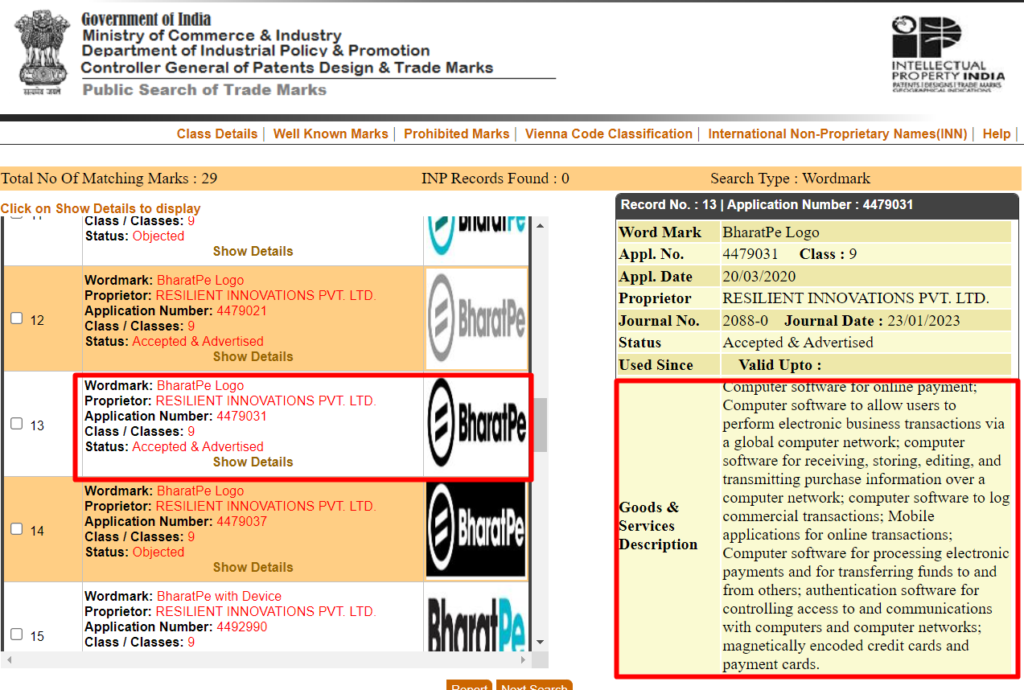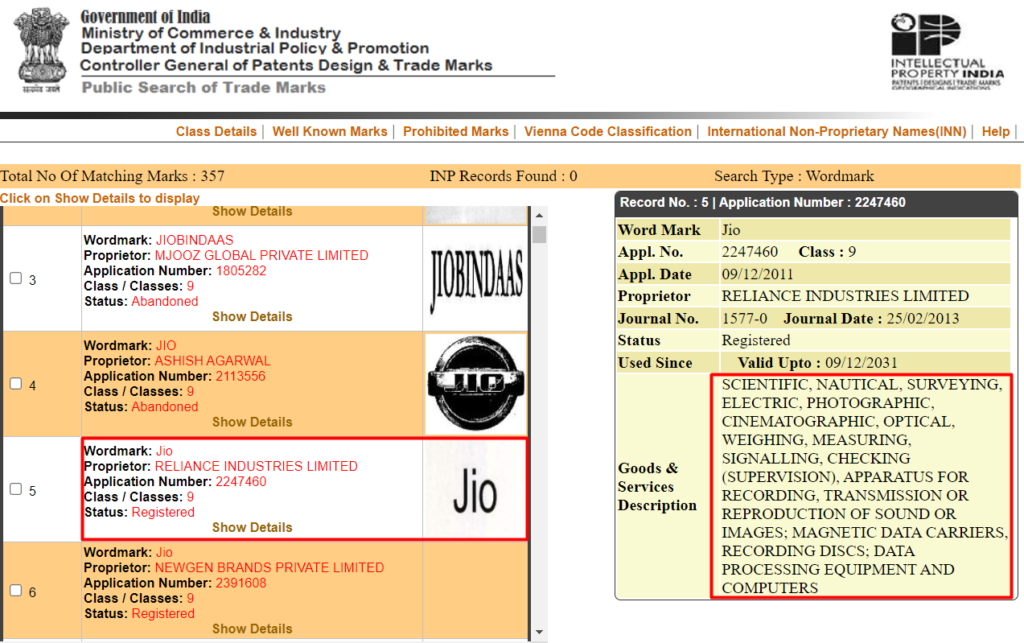
Types of Trademark Status with Meaning

Trademark status refers to the current position or stage of a trademark application or registration in the legal process. It indicates the progress and actions taken by the trademark office or registry regarding a particular trademark. The status helps to track the trademark’s journey and provides information on the application’s or registration’s current state and any pending actions or requirements.
Trademark status can include various stages such as:
This status indicates that a trademark application has been filed with the Indian Trademark Registry but has not yet been examined.
After filing, the trademark application goes through a formalities check to ensure all necessary documents and information are provided correctly. If the application passes this check, it receives the status of “Formalities Check Pass.”
Once the trademark application clears the formalities check, it is assigned to an examiner for substantive examination. The examiner reviews the application for compliance with legal requirements and examines the distinctiveness and availability of the proposed trademark. If no objections or concerns are raised, the status becomes “Examined.”
If the examiner finds any issues with the trademark application, such as similarity to existing trademarks or lack of distinctiveness, they issue an examination report raising objections. The status then changes to “Objected,” and the applicant must respond to the objections within a specified period.
If the applicant successfully addresses the objections raised by the examiner, the trademark application is accepted, and the status changes to “Accepted and Advertised.” The accepted trademark is published in the Trademark Journal for public scrutiny, and third parties have an opportunity to oppose the registration within a specified period.

If any interested party opposes the registration of a trademark during the opposition period, the status changes to “Opposed.” The opposition proceedings are conducted, and the Registrar considers the arguments from both parties before making a decision.
If there are no oppositions or if the opposition is unsuccessful, the trademark application proceeds to registration. The status changes to “Registered,” and a registration certificate is issued. The trademark is then protected under the Indian Trademarks Act, providing exclusive rights to the owner.

A trademark registration may be removed from the registry due to various reasons, such as non-renewal of the registration, cancellation by the owner, or non-use of the mark for a continuous period of five years. In such cases, the status changes to “Removed,” indicating that the trademark is no longer valid or protected.
When a trademark application is objected to, it means that the trademark examiner has raised concerns or objections regarding the application. This typically occurs after the examination of the trademark application by the trademark office.
The objections can be based on various grounds and may vary depending on the specific jurisdiction’s trademark laws and regulations. Here is a general overview of what happens in a trademark objection process:
The trademark applicant receives an official communication from the trademark office known as an Examination Report or Office Action. This report outlines the objections or concerns raised by the examiner regarding the trademark application.
The applicant should carefully review the objections mentioned in the Examination Report. The objections can relate to issues such as lack of distinctiveness, similarity with existing trademarks, descriptive nature of the mark, conflicting prior rights, improper classification, or failure to comply with formal requirements.
The applicant must prepare and submit a comprehensive response addressing each objection raised by the trademark examiner. The response should include legal arguments, evidence, and supporting documents to overcome the objections.
The trademark office reviews the response submitted by the applicant. The examiner evaluates whether the response adequately addresses the objections and provides satisfactory arguments or evidence to support the registration of the trademark.
Depending on the jurisdiction and the complexity of the objections, the trademark office may take further action. This can involve requesting additional information, evidence, or clarification from the applicant. In some cases, a hearing may be scheduled to allow the applicant to present arguments in person.
Final Decision: After considering the applicant’s response and any additional information provided, the trademark office will make a final decision regarding the trademark application. The decision can result in one of the following outcomes:
a. Acceptance: If the objections are successfully overcome, the trademark application will proceed to the next stage, which is typically publication and registration.
b. Rejection: If the objections are not adequately addressed, the trademark application may be rejected. The applicant will have the option to appeal the decision or make amendments to the application if allowed.
The term “Trademark Status Opposed” refers to a specific stage in the trademark registration process where a third party opposes the registration of a trademark application.
When a trademark application is published for opposition, it allows interested parties to review the proposed trademark and file an opposition if they believe it conflicts with their existing rights or violates any trademark laws.
Here’s a breakdown of the meaning and implications of a trademark status opposed:
After the trademark application undergoes examination and is found to meet the necessary requirements, it is published in the official trademark journal or gazette. This publication serves as public notice of the pending trademark registration.
Following publication, a specific period is provided during which interested parties can file an opposition. The opposition period varies by jurisdiction but is typically around 30 days.
During the opposition period, any party who believes that the registration of the trademark would infringe upon their existing rights can file an opposition. The opposition should be supported by valid legal grounds, such as prior use of a similar mark or likelihood of confusion with an existing mark.
Once an opposition is filed, the trademark office reviews the opposition and considers the arguments and evidence presented by both the applicant and the opposing party. The examination involves evaluating the validity of the opposition and assessing whether it raises legitimate concerns regarding the registration of the trademark.
Based on the examination of the opposition, the trademark office will make a decision on whether to accept or reject the opposition. This decision is typically based on the merits of the opposition and the applicable trademark laws and regulations. If the opposition is accepted, it may result in the refusal or cancellation of the trademark application. If the opposition is rejected or not upheld, the trademark registration process may proceed.
It’s important to note that the specific procedures and timelines related to trademark opposition can vary depending on the jurisdiction. It is advisable to consult with a trademark attorney or professional well-versed in the trademark laws of the relevant jurisdiction to understand the specific requirements and implications of trademark opposition. They can guide you through the opposition process and help protect your trademark rights effectively.
Let us know your feedback on this article “Types of Trademark Status with Meaning” in the comments below 👇

Sunil Kumar Sah @DigitalSunilSah
Sunil is an E-commerce Seller, Blogger, YouTuber and Digital Marketer. He is a digital enthusiast and passionate about Online Selling. He loves sharing his knowledge and experiences on eCommerce in this blog and on his Hindi YouTube Channel “Ecommerce with Sunil” and the English Channel “Ecomsprint“
| Cookie | Duration | Description |
|---|---|---|
| cookielawinfo-checkbox-analytics | 11 months | This cookie is set by GDPR Cookie Consent plugin. The cookie is used to store the user consent for the cookies in the category "Analytics". |
| cookielawinfo-checkbox-functional | 11 months | The cookie is set by GDPR cookie consent to record the user consent for the cookies in the category "Functional". |
| cookielawinfo-checkbox-necessary | 11 months | This cookie is set by GDPR Cookie Consent plugin. The cookies is used to store the user consent for the cookies in the category "Necessary". |
| cookielawinfo-checkbox-others | 11 months | This cookie is set by GDPR Cookie Consent plugin. The cookie is used to store the user consent for the cookies in the category "Other. |
| cookielawinfo-checkbox-performance | 11 months | This cookie is set by GDPR Cookie Consent plugin. The cookie is used to store the user consent for the cookies in the category "Performance". |
| viewed_cookie_policy | 11 months | The cookie is set by the GDPR Cookie Consent plugin and is used to store whether or not user has consented to the use of cookies. It does not store any personal data. |
